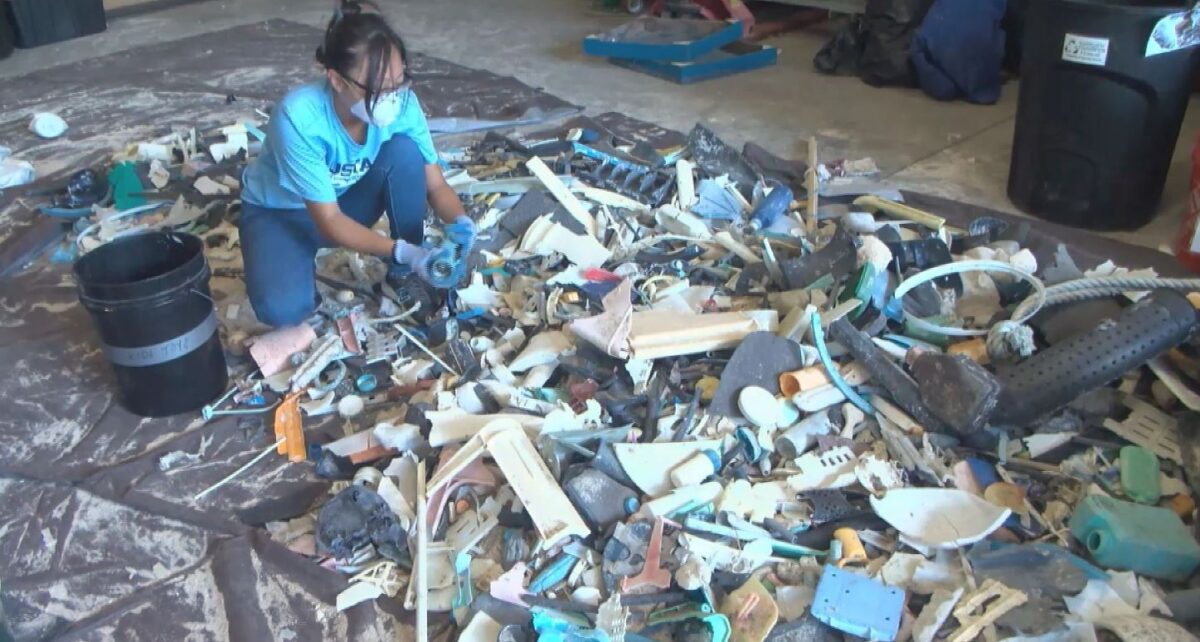50,000 pounds of marine debris sorted for science

By Kimber Collins
Click here for updates on this story
KAILUA, Hawaii (KITV) — Inside a Windward Oʻahu warehouse, piles of trash cover the floor, fishing nets, oyster spacers, toothbrushes, toys, even mannequin heads and duck decoys.
It may look like garbage, but to scientists and volunteers, it’s valuable data.
“We have this incredible team that’s here that is sorting it all out and categorizing it by piece so that we can better understand what it is that shows up on our coastlines,” said Rafael Bergstrom, Sustainable Coastlines Hawaiʻi Executive Director.
Volunteers carefully dump debris, sift through the piles, and place each item into labeled bins. Some items come with unexpected surprises.
Sarah Jeanne Royer with The Ocean Cleanup pointed out a plastic bottle covered in clear bite marks.
“This bottle is really interesting because we can clearly see the bite marks,” Royer said.
Every piece is weighed, recorded, and logged into a global database to help researchers pinpoint the sources of marine debris.
This effort is part of Marine Debris Catch Analysis Volunteer Week, where Sustainable Coastlines Hawaiʻi (SCH) joined forces with The Ocean Cleanup and the Papahānaumokuākea Marine Debris Project (PMDP).
Together, they are processing debris collected from Laysan Island and Kalaupapa.
“It comes from Asia, the Aleutian Islands, Alaska, the Pacific Northwest, even all the way down to the equatorial region,” explained James Morioka, Executive Director of the PMDP.
According to SCH, 60% of the debris comes from commercial fishing vessels. The rest is man-made trash that has drifted across the Pacific.
This batch of debris alone weighed in at 50,000 pounds, but experts warn it’s just a small fraction of what the ocean holds.
“Our lifestyles, our world, is contributing this much plastic to the oceans, which has detrimental effects, from how it affects the animals in the ocean to how it affects us as we breathe in all of this plastic, or ingest the plastic,” Bergstrom said.
Every year, an estimated 115,000 pounds of marine debris accumulate in Papahānaumokuākea, according to Morioka.
“Our goal is to remove two years’ worth, we set our to catch up and keep up essentially. ” he added.
The debris doesn’t just end with cleanup. Researchers analyze the data and publish scientific papers that influence global decision-making.
“Once we analyze everything, this is to understand the main goal: where are these debris coming from, how they’ve been sitting out there. And then the idea is to use that scientific paper to have the large policy makers reading that and designing better laws to stop that pollution from the source,” said Royer.
After analysis, the debris is recycled, repurposed or incinerated, ensuring none of it returns to the ocean.
For Sustainable Coastlines Hawaiʻi, this work builds on a mission years in the making. The nonprofit has already removed more than 750,000 pounds of debris from Hawaiʻi’s shores, reached 55,000 students with educational programs, and mobilized 50,000 volunteers.
While the mountain of debris can feel overwhelming, organizers said efforts like these prove that solutions begin with understanding, and every piece of trash tells a story.
Please note: This content carries a strict local market embargo. If you share the same market as the contributor of this article, you may not use it on any platform.